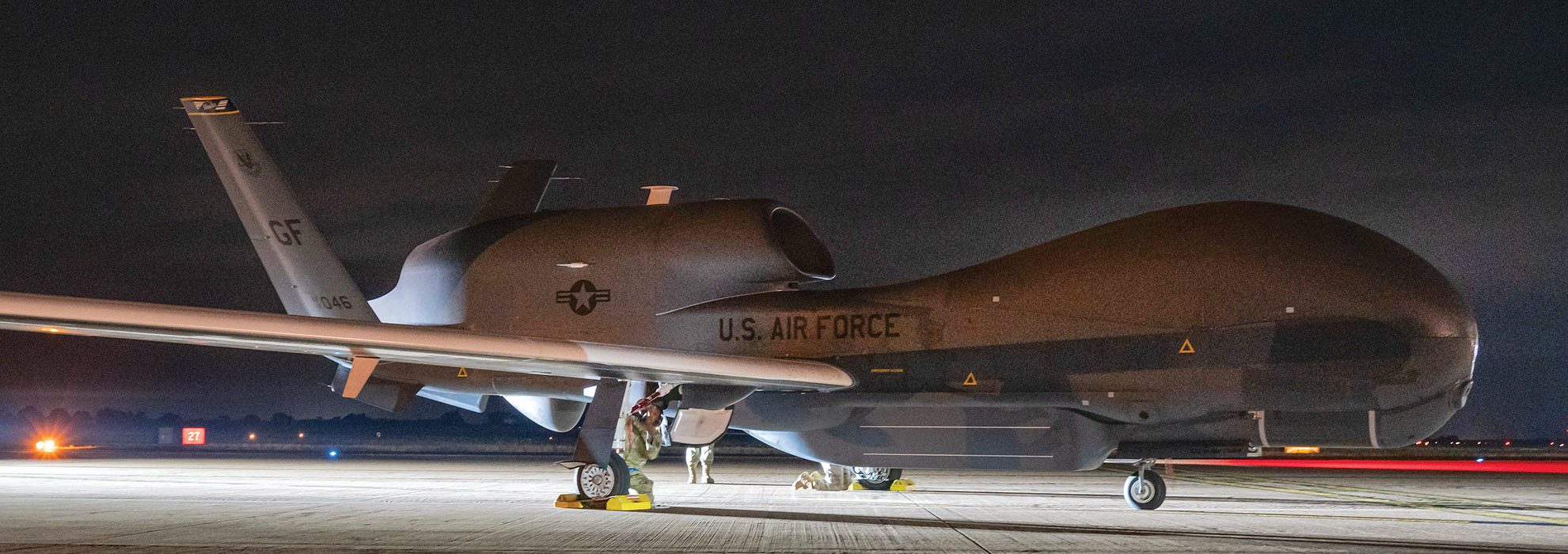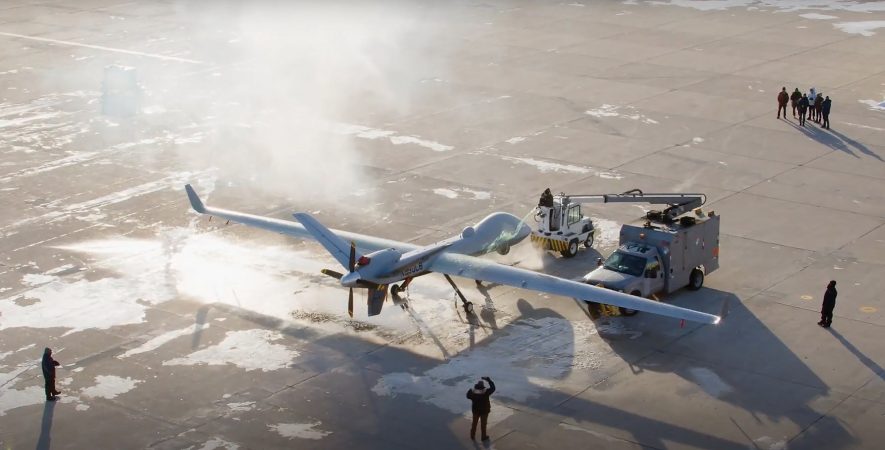Uncrewed aircraft could complement satellites and ground-based radars in an increasingly contested region.
NATIONAL HARBOR, Md.
R
ussia’s increasing Arctic presence and growing ties with China have Air Force leaders beginning to use unmanned aircraft to help monitor the region for situational awareness.
“We’ve been experimenting with the MQ-9s, with Global Hawks … trying to go up farther north in the Arctic Circle, which we haven’t done in the past,” said Gen. James B. Hecker, commander of U.S. Air Forces in Europe.
The mission is a new one for the MQ-9 Reaper, but the hunter-killer’s 27-hour endurance is well suited for long-endurance missions. The RQ-4 Global Hawk, which operates at higher altitudes and can stay aloft for 34 hours, could provide a persistent complement to satellites and manned aircraft. USAFE deployed an RQ-4 to RAF Fairford, U.K., in August, the first time the surveillance drone has operated there.
Uncrewed aircraft are a smart, cost-effective, and low-risk solution to address limited air and maritime surveillance in the region, said retired Air Force Maj. Gen. Larry Stutzriem, director of research at AFA’s Mitchell Institute for Aerospace Studies.
Gen. Gregory M. Guillot, commander of the North American Air Defense Command and U.S. Northern Command, said the drones are a “gap filler” in the Arctic until future over-the-horizon radars come online. Experiments are necessary to adapt the drones’ sensors and payloads to the region’s brutal weather and he is intrigued with the work of the U.S. Air Force’s Task Force 99 in the Central Command area of operations in the Middle East. The task force has experimented widely to enhance ISR and logistics in the Middle East.
The Air Force is refurbishing older Global Hawk Block 20 and 30 models at Grand Forks Air Force Base, N.D.
Stutzriem said the experimentation makes use of the inherent flexibility in these uncrewed aircraft. “It’s all about sensors for the Arctic mission,” he said. “The UAVs can be configured for both air and maritime surveillance.”
Electro-Optical/Infrared (EO/IR) sensors and Synthetic Aperture Radar (SAR) systems on the Reapers and Global Hawks enable them to sense through clouds and fog and could also be valuable in operating through prolonged low-light conditions during winter for monitoring weather and to track sea ice movement.
Evolving Threats, Delayed Capabilities
The Arctic is 1.5 times the size of the continental U.S. Though mostly international territory, much of the region belongs to Russia, which holds the largest share of coastline and an exclusive economic zone (EEZ). Hecker said Russia is now employing radars and satellites they “haven’t used before” to expand its situational awareness across the region.
“They’re getting a lot more information in that domain than they’ve had before, way up north,” Hecker said. “That concerns us.”
Norway, an Arctic neighbor, has also noted Russia’s increased activity. “On average, per year, we intercept Russians once or twice per week, and we see their ships all the time,” said Maj. Gen. Øivind Gunnerud, Chief of Royal Norwegian Air Force.
Russia’s increased operations approached Alaska’s coast repeatedly in September, with planes entering Alaska’s air defense identification zone (ADIZ) four times in five days. Lt. Gen. Case Cunningham, chief of Alaskan Command and U.S. Northern Command, said those recent flybys did not show a weapon profile, but Russian bombers in future missions could carry cruise missiles, posing a strategic risk.
“The Russians have modernized their cruise missile capabilities and have postured them in key regions,” said Stutzriem. Russian Kalibr long-range precision missiles and hypersonic Zircon missiles, which can reach Mach 9, pose a particular challenge. “We don’t have enough domain awareness to provide sufficient decision time to effectively dissuade or deter such threats,” Stutzriem said. “That puts us at a significant disadvantage from a homeland security perspective.”
Former NORAD boss retired Gen. Glen D. VanHerck sought better Arctic monitoring and increased funding to defend the High North, efforts that gained urgency after a Chinese spy balloon slipped past NORAD radars undetected in early 2023, drifting all the way across the U.S. before being shot down over the Atlantic.
But Cunningham said what is most concerning now “is Russia’s cooperation with the PRC (People’s Republic of China).”
In July, NORAD tracked two Chinese Xian H-6s and two Russian Tu-95s, escorted by Russian fighter jets, flying through the Alaskan ADIZ. It was the first appearance of Beijing’s bombers in a combined patrol through the area.
U.S. experts said the flights marked the eighth time the two flew together since 2019, and while they don’t signify true interoperability, they remain a “significant” concern.
“Russia is providing access to China,” Cunningham said. “Those [Chinese] H-6K bombers took off from a Russian air base.”
Guillot noted that “China spends a lot more time up there” in the Arctic today than it did in years past. “It shows, on a daily basis, that the Arctic is an area where a number of nations are showing interest, not only for military purposes, but also for scientific purposes.”
Since declaring itself a “near-Arctic State” in 2018, China has demonstrated its interest in the Arctic for both economic and strategic reasons. Beijing views melting ice caps as a gateway to new trade routes, and it may seek to leverage Russia’s Arctic activities to bolster its own presence and awareness in the region.
Meanwhile, U.S. observers fret that the Air Force is dragging its feet on acquiring OTHR capability in the Arctic region. The service has pushed back its investment from 2024 to at least 2026.
Stutzriem said drones are not a replacement for that system, but a complement: Once the radar arrives, air-breathing sensing will remain “indispensable for real-time, detailed information gathering.”
“There’s always a need for aircraft to complement over-the-horizon radar (OTHR) and space-based sensors,” Stutzriem said. “While space-based sensing will grow over time, airborne sensors remain vital for focusing on specific areas, to provide higher-fidelity data, precise target location, and tactical, targeted operations.”
Drone Variants
New variants of proven uncrewed airframes are now available. Among them: the Navy’s MQ-4C Triton, a variant of the high-altitude, long-endurance RQ-4, and MQ-9B SkyGuardian. Building on the features of the original Global Hawk and Reaper, these variants have upgraded “state-of-the-art de-icing systems,” for Arctic and NATO operations, Stutzriem said.
Northrop Grumman demonstrated the Triton’s de-icing capabilities in September, operating the drone for an ISR mission 50,000 feet about the Arctic Circle, the first time it was tested in the region. Earlier in 2023, General Atomics put SkyGuardian’s de-icing systems to the test, with a 12-hour “cold soak” followed by de-icing at minus-5 degrees Fahrenheit. Shortly after, the company secured a deal with Air Force Special Operations Command (AFSOC) to operationalize the drone.
The United Kingdom, Canada, and Belgium are also on board with the MQ-9B, and Norway has expressed interest in the Triton. Sweden is evaluating both aircraft, according to Stutzriem.
Other options are also attracting attention. Hecker said USAFE is “exploring” new solar-powered electric drones. For instance, the Airbus Zephyr has been tested by the U.S. Army for ISR missions and can fly for months at 70,000 feet, making it a strong candidate for Arctic surveillance. Manufacturers like Boeing and AeroVironment are also investing in high-altitude solar-powered UAVs for defense and commercial use. These drones offer extended airborne capabilities as long as there’s sunlight, but they also come with challenges to consider.
“The effectiveness of these systems depends on the sensor payloads and the kind of data, accuracy, and resolution you require,” Stutzriem explained.
Solar UAVs are new and lack the power and payload capacity of conventionally powered systems. Solar power requires large surfaces, making such UAVs potentially more vulnerable to countermeasures, Stutzriem said. “While these are promising solutions that should be explored, the existing solutions, such as the SkyGuardian and Triton, are already well-tested, well-understood, and easy to control,” he added.
And with NATO now encompassing Sweden and Finland, both bordering Russia—those drones will now be able to extend surveillance even farther.
“C4ISR is easier for those nations when integrating with the infrastructure we have, which is crucial,” said Gunnerud.
Hecker said NATO wants to build a third Combined Air Operations Center (CAOC), in addition to existing ones in Spain and Germany, “fairly shortly.” That new CAOC might well be in a northern location, where it could oversee NATO’s air policing missions.
“The experience we get from the Arctic nations up north is just invaluable,” said Hecker. “We’re going to exploit that close relationship between the Arctic nations.”



